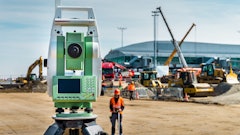
Thank you for joining us on Construction Tech Talk for another product snapshot. This is Technology Editor Charles Rathmann.
There’s no shortage of old-school on-premise estimating systems—and some modern software-as-a-service applications too. So why are the who’s who in construction tech funding an estimating solution—I’m talking Bill Smith from the rental app Landing, Will Schlacks from EquipmentShare and Ryan Sutton-Gee of PlanGrid. Well, we’re about to find out as we talk about CostCertified!
What we notice right away when we learn about Calgary-based CostCertified is that they are not just focused the estimate. They see estimating as central to the sales process … there is an embedded multi-user CRM or customer relationship management tool in the application. You create and track leads, who owns them, where they came from, contact information—all the usual stuff you put in CRM.
There is of course estimating, and tools for during the project like change orders which are really like revised estimates—right? The software takes that estimate and generates a digital proposal for a prospective owner. For subcontractors, the software also tracks payments and jobs or tasks they have to complete. And for project owners, the software presents an interactive estimate, a project dashboard and can track payments against the project. There are also some cool Aye-Eye features coming and a unique approach to estimating that to me, reveals a different philosophy of construction than you normally see. First though, consider what most estimates look like.
They are an itemized list of things to be done. They scroll a screen of most devices a few times. But still, there is very little information on the details of the project attached to those numbers. An estimate may include line items for cabinetry … but which cabinets. Tile work—great … but what does this look like? Which tile is specified? Sometimes the estimate is in a web portal and you have to take screen caps of it—it isn’t even in a PDF! That’s just poor and does not help close the sale.
By contrast, a CostCertified estimate presents deeper insights and creates additional revenue opportunities through upgrades or can keep a customer on the hook with cheaper options if they want to opt for more spartan fixtures. Think about how much back and forth with the owner this eliminates. And think about how it gives the customer a sense of control, enabling them to make choices and generate a revised estimate in real time.
As the customer chooses different options, the estimate updates automatically, in terms of fixtures and materials … labor … everything. A Cost Certified estimate is more like a showroom, where a project owner can select options with the price automatically reflowing. Each option can have multiple lines of variation each with different imagery and price points. To me, this looks like what folks in the ERP business call a sales configurator. And it shows us that many times construction can have a strong configure-to-order business model. Looking at it that way helps us create an experience that puts the customer in control, making for a more streamlined project sales process.
All of this is delivered by a pretty complex software architecture on Amazon Web Services. The tech stack uses a combination of My SQL, MongoDB, Elasticsearch and Redis. These are open source technologies. This is a common way for this new breed of construction software companies to get advanced functionality to market quickly. But contractors ought to review the contract terms and ask vendors how frequently the open source tools they rely on are patched. End users collaborate in forums to share security exploits and vulnerabilities they find in the software, and patches are then made available.
The big takeaway … is that this is an effective way for both users and bad actors to learn of potential ways to hack the software. CostCertified is on a daily release cycle—the software is updated every single day for bug fixes and functionality improvements. But buyers may want to ask CostCertified about how they are managing security on their open source technologies—due diligence is important here, folks. A LOT of the new breed of construction apps are housed on AWS, which has had its outages. CEO Michael Bignold told me that one outage affected a file server for pictures used in the application, but the rest of the application still ran. They house the software in multiple zones on AWS which should prevent these issues, but this is one more thing construction app buyers ought to do some due diligence. There is more going on and coming down the pike from this company than just Ay Doubleyou Ess Tweaks, bug fixes and incremental updates.
CostCertified already has some functionality for to manage information on subcontractors, which is what we see here. The big deal is what company is preparing now … a tool for frictionless subcontractor management. Subs will use the tool to share progress on deliverables, upload photos and manage documentation like insurance certification. All of that goes to the GC and then the customer for approval, and faster approval of applications for payment incents subs to use the portal. The product uses artificial intelligence to identify plumbing, framing, electrical and other elements that align with different construction disciplines and then automatically bid out. So from solicitation of bids through to application for payments, CostCertified will streamline contact with subs and the quoting process timeline shrinks from days to minutes.
Other stuff coming … a Quickbooks accounting integration and an integration framework you can use to build bidirectional integrations to other applications using application programming interfaces. So the company has big plans, but can they deliver? Well, they already have five thousand contractors in the system and a good relationship with some industry-savvy investors. The size of the addressable market determines to some extent whether they can get to where they want to go—whether there is an upside for that venture cash.
So who is the product for? Who is a fit? Right now, the primary value add is to residential because of the consumer-friendly interactive estimates. CostCertified can also expose its CRM to create a lead generation form for a contractor’s web site or to accept leads from an external source. So we are talking about remodeling contractors, homebuilder or specialty contractors with between two and five million dollars in revenue and typically between four and fifteen employees. But the company does have customers with as little as two hundred and fifty k in revenue. The subcontractor tool will make the addressable market even bigger by opening up the light commercial market. So let’s talk about pricing and cost. CostCertified’s pricing strategy is built around the number of jobs, users and the impact the customer will have on the sass software system.
So pricing should scale down for a smaller more rudimentary contractor and up for a contractor with thousands of options, assemblies, inventory items and images that drive estimates. Cost is more than price though—you have internal costs as you ramp up on new software. Most customers can be live and productive on CostCertified with a two-week turnaround but a tech-savvy contractor with an engaged staff may be off and running on the first day. Sometimes according to Bignold it takes a little longer if a staff has to get their head around doing things differently. There is some heavy lifting too to get a contractor’s data populated into CostCertified. An onboarding team helps customers import a database of pre-existing items including indexed labor and material items. Sometimes, materials or product data sources can be migrated their inventory with a shopify link. Bottom line—CostCertified is showing us a new and streamlined approach to estimating and will drive their tech-forward thinking into other construction business processes. Residential contractors in a position to give customers choices during estimating ought to look hard at CostCertified. Nonresidential contractors ought to follow the company closely as they release their subcontractor functionality and be the first in their market to take advantage of some really cool tech.



























